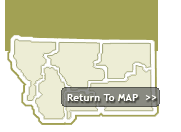

| Home | Communities | Accommodations | Places To Go | Things To Do | Site Map |
|
Glacier Country
Central Montana
Missouri River Country
Southwest Montana
Yellowstone Country
Southeast Montana
|

| ||||
The world famous Custer Battlefield Museum is located at Exit 514, off.I-90.
The Custer Battlefield Museum is dedicated to collecting and preserving the history of Western Expansion on the American high plains, including artifacts, manuscripts and memorabilia related to the Seventh Cavalry, frontier military life and Plains Indian tribes. Featuring the David F. Barry photograph collection featuring more than 100 photos printed from the original glass negatives.
Tomb of the Unknown Soldier
The remains of this unknown trooper were found in 1926 prior to the 50th Anniversary of the Custer Battle. Presumed to have been one of Major Reno's men, one of the first Seventh Cavalry men killed in the opening phase of the battle in the river valley near Garryowen, Montana. Apparently high water in the spring following the famed battle, caused the soldier's body to be buried, and it was not found until the road crew building the US 87 Highway uncovered it 50 years later.
'Peace Monument'
Now 125 years after the Battle of the Little Big Horn the Custer Battlefield Museum unveiled a new 'Peace Monument' which is located behind the Tomb of the Unknown Soldier. Featured on each side of the Granite Peace Monument is a bronze sculpture of Sitting Bull and General George Armstrong Custer.
In 1895 the Chicago, Burlington and Quincy Railroad established a tiny station on the Little Bighorn River, where water was taken on, and U.S. Army troops, supplies and mail were off-loaded for delivery to nearby forts.
The site was originally named for the marching song of the 7th Cavalry, which was under General George Custer's command at the Battle of the Little Bighorn. Myles Keogh, one of Custer's officers, carried the tune and words from Ireland. It had been the marching song for the Royal Lancers at Garryowen, Ireland, a famous British unit, of which Keogh's father was an officer..
Garryowen is located in southeastern Montana, south of Hardin on I-90.
Garryowen AccommodationsPrivate Campground (1)Garryowen RestaurantsSandwich Shop/Deli (1) | All Garryowen BusinessesGift Shop (1)Landmark (1) Museum (1) Specialty Tour (1) |
Cities near Garryowen Montana
| Ballantine Bighorn Birney Busby | Colstrip Crow Agency Custer Decker | Fort Smith Garryowen Hardin Lame Deer | Lodge Grass Rosebud Sanders St. Xavier | Wyola |
A source for Montana Travel & Tourism Information
![]()